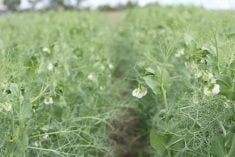Commodity funds have moved into the livestock futures markets like a nomadic horde surrounding a walled city.
Whether they will help build up the countryside or loot the land and then move on remains to be seen, analysts say.
But while they’re around, there’s no reason not to make some money from their presence.
“As usual, (commodity funds) have driven the futures too high,” said ProMarket Communications adviser Errol Anderson about Chicago Mercantile Exchange beef contract prices.
“They’re really overbought. These times offer really good hedging opportunities for Canadian cattle feeders.”
Read Also

Prairies have variable soil moisture conditions
The dry weather in the west was welcome for preserving grain quality and advancing harvest, but it has resulted in very dry soil moisture conditions.
Commodity investment funds tend to increase futures market volatility because they use mathematical trading models that will drive prices beyond what fundamental supply-demand analysis would warrant.
Cattle futures prices have recently soared far higher than they should be when judged by fundamental factors. When prices turn down, they will probably fall much faster than justified, Anderson said.
For livestock sellers, that means taking advantage of high prices and avoiding the lows. Since fundamentals aren’t driving prices, livestock sellers have to be willing to hedge more aggressively, Anderson said.
Tyler Fulton, a risk management specialist with Manitoba Pork Marketing Co-operative, said the increased fund activity has made it safer and easier for farmers to close out futures positions because there’s always someone looking to make a trade.
But he said it is too early to know whether pork futures prices are being driven up or down by the increased liquidity.
“I’m not sure I’ve seen any adverse increases in volatility as a direct result,” said Fulton.
“The jury is still out.”
Fulton said the new hedge fund activity only became obvious in April, so it may be some time before conclusions can be drawn. While pork futures markets have been tempestuous, so have cash prices, so it is impossible to prove commodity funds are responsible for price swings.
Ken Ball of Union Securities in Winnipeg said commodity fund investing has greatly increased trade in agricultural commodity futures contracts, but it is hard to reach a conclusion about their impact.
Each fund follows a unique investing strategy, so it’s hard to make blanket statements about fund activity. Some information about speculative positions is available in official reports such as the Commitments of Traders reports, but these are not well detailed and they do not reveal funds’ complex and intertwining strategies.
“It’s very hard to assess the success of some of these positions, because we may be seeing only half of their position,” said Ball.
“A lot of these companies are creating and floating special indexes and then trading futures against the indexes in an arbitrage kind of fashion. Their risk may be far less than we realize.”
Ball said increased liquidity is one unquestionable result of fund activity, and much of that increased liquidity will probably remain, even when livestock prices fall.
“A lot of the new money is buy-only,” said Ball.
Some funds want to hold positions in commodities and are less willing than traditional commodity funds to reverse positions from buyer to seller to chase market momentum.
A lot of the fund money that drove corn and wheat prices high earlier this year has recently moved out of grain markets, analysts say. Some of it went into livestock.
But whether it will stay in livestock, flow back into grain or leave agriculture altogether can’t be forecast. The motivations and behaviours of the funds remain inscrutable.
“It’s very hard to tell who’s doing what to whom and why,” said Ball.
“It’s much, much, much more complicated than it was five or eight years ago before all this money came in.”















